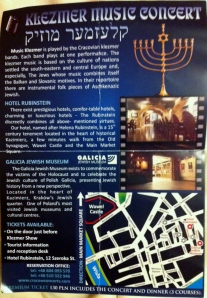WE HAVEN’T CONSULTED the list of “1000 Places to See before you Die,” but I’m guessing Krakow makes the cut. Its stately, medieval charm is possibly the biggest surprise of our Central European tour. One could argue that when Krakow’s most prominent citizen, Karol Cardinal Wotyla (later Pope John Paul II) was tapped for promotion, it took no less than Rome to lure him out of this city.
We board and disembark our tour coach just outside the medieval gates and preserved stretch of city wall just outside the Old Town, where most traffic is forbidden during business hours. Our hotel, inside a classic building on Florianska Street near the market square, offers rooms with what seem like 18-foot ceilings, old-fashioned silhouette portraits, and tastefully-coordinating modern furniture. Every hotel on this tour (all of them excellent and strategically placed) is quiet—beyond a New Yorker’s comprehension. But even the double-window dampening can’t keep out the celebratory whoops: Krakow’s soccer team has won the national championship!
The huge market square, ringed with Old World churches, shops, cafes, and restaurants, has its own districts, offering art, outdoor eating, flowers, lace and other handicrafts. The covered bazaar near the center houses an array of shops selling amber, lace, dolls, ceramics, bright scarves and much more.
Through the day, a trumpeter sounds the hour successively in four directions from windows near the top of one of St. Mary’s Church’s two high steeples. He plays a distinctive Krakow fanfare, as a similar trumpeter plays a Prague trademark riff from a tower in the Bohemian capital.
The baroque interior of this church is the most opulent this traveler had seen ever seen—so far. It will take St. Vitus’ Cathedral in the Prague Castle to surpass it. The altar at St Mary’s, incorporating over 200 carved figures, is a singular marvel.
Gray, rainy days give way to sun, and the whole world seems to turn out in Old Town Square, providing carriage drivers and some unusual entertainers an audience. Painted mimes stand rock-still, imitating statues, and startle particularly gullible tourists who pose with them when they suddenly show signs of life. One performer, dressed in faded desert garb, draws and confounds a crowd. He appears to sit on thin air, holding only a staff that touches the ground. puzzled onlookers assume it has something to do with his seemingly effortless stability.
WE APPROACH WAWEL CASTLE (the Ws are all Vs here, Mr. Wagner), some distance from the Old Town, traversing winding streets that juxtapose venerable churches, fountains, and saintly figures on a substrate of centuries-old cobblestones.
This former royal residence holds its own among Europe’s greatest. Its dazzling royal apartments encircle a huge interior courtyard—a town square of its own. Sorry, no photo-taking allowed inside, but a few shots are to be found on the web, and, of course, in books at the gift shop.
KRAKOW’S JEWISH QUARTER is named Kazimierz, after King Kasimirz the Great (1333-1370), who invited Jews, expelled from other kingdoms, to Poland. From here and elsewhere in Krakow, 600 years later, the occupying Nazis herded the city’s 65,000 Jews into a ghetto in Lublin, in the East of Poland, or to another in Podgórze, across the river from Krakow. From these ghettos they packed them in trains to nearby murder camps—Auschwitz and Plaszów. Only a few thousand survived and today, only 200 or so Jews live in Krakow.
The Kazimirz district offers virtually unlimited opportunity for building renovation and business development.
Oskar Schindler’s factory (used by Stephen Spielberg in filming Schindler’s List) lies in an industrial area blocks away.
As we are touring the quarter, I wonder how we can snag tickets for a Klezmer music concert this weekend. Then someone appears, handing out flyers for a performance that night. I ask where tickets are sold, and he points to the lobby of the building behind us. At the Helena Rubenstein House (the cosmetic queen lived in the neighborhood, as did film director Roman Polanski), we do indeed find tickets for a concert at the Galicia Jewish Museum, not far from the Old Synagogue—featuring a brilliant young trio playing among the Holocaust exhibits.
This award-winning ensemble call themselves Di Galitzyaner Klezmorim http://www.klezmorim.pl/rameng.html. They perform for an audience of about twenty, including six from our tour group; it should have been two thousand. We recognize half the music from New York performers and recordings. The soulful clarinettist, tall even before climbing into her spike heels, is too young to have studied with Argentine clarinettist Giora Feidman in Israel, but her energetic, tenderly sensitive playing say that she grew up listening to his recordings. Her amazing accordionist husband sounds four-handed, and the bassist turns his hollow instrument into a percussion section without warning.
The marvels below decks begin with endless tunnels, widening into chambers of varying sizes, holding and displaying figures of miners, horses, and mining machinery (all of it wooden, as are all the old and modern bracing and walkways). With little warning, tunnels open into immense caverns, subterranean pools and canals, vertical shafts, and various memorials, shrines, and placements of whimsical figures of trolls, gods and kings.
This salt mine is a gold mine. Centuries ago, about a third of Poland’s income came from sale of the salt excavated here. Today, its expanses bring new revenue from tourism and space rentals for concerts and parties. Restaurants serve meals, church services bring worshipers, and the mine attracts throngs of explorers armed with cameras instead of pickaxes.



















Leave a comment